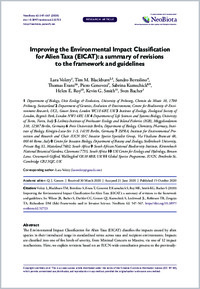Improving the Environmental Impact Classification for Alien Taxa (EICAT): a summary of revisions to the framework and guidelines
- Volery, Lara Department of Biology, Unit Ecology & Evolution, University of Fribourg, Chemin du Musée 10, 1700 Fribourg, Switzerland
- Blackburn, Tim M. Department of Genetics, Evolution & Environment, Centre for Biodiversity & Environment Research, UCL, Gower Street, London WC1E 6BT, UK - Institute of Zoology, Zoological Society of London, Regent’s Park, London NW1 4RY, UK
- Bertolino, Sandro Department of Life Sciences and Systems Biology, University of Turin, Turin, Italy
- Evans, Thomas Leibniz-Institute of Freshwater Ecology and Inland Fisheries (IGB), Müggelseedamm 310, 12587 Berlin, Germany - Freie Universität Berlin, Department of Biology, Chemistry, Pharmacy, Institute of Biology, Königin-Luise-Str. 1-3, 14195 Berlin, Germany
- Genovesi, Piero ISPRA, Institute for Environmental Protection and Research and Chair IUCN SSC Invasive Species Specialist Group, Via Vitaliano Brancati 48, 00144 Rome, Italy
- Kumschick, Sabrina Centre for Invasion Biology, Department of Botany and Zoology, Stellenbosch University, Private Bag X1, Matieland 7602, South Africa - South African National Biodiversity Institute, Kirstenbosch National Botanical Gardens, Claremont 7735, South Africa
- Roy, Helen E. UK Centre for Ecology and Hydrology, Benson Lane, Crowmarsh Gifford, Wallingford OX10 8BB, UK
- Smith, Kevin G. Global Species Programme, IUCN, Pembroke St, Cambridge CB2 3QZ, UK
- Bacher, Sven Department of Biology, Unit Ecology & Evolution, University of Fribourg, Chemin du Musée 10, 1700 Fribourg, Switzerland
-
15.10.2020
Published in:
- NeoBiota. - 2020, vol. 62, p. 547–567
English
The Environmental Impact Classification for Alien Taxa (EICAT) classifies the impacts caused by alien species in their introduced range in standardised terms across taxa and recipient environments. Impacts are classified into one of five levels of severity, from Minimal Concern to Massive, via one of 12 impact mechanisms. Here, we explain revisions based on an IUCN-wide consultation process to the previously- published EICAT framework and guidelines, to clarify why these changes were necessary. These changes mainly concern: the distinction between the two highest levels of impact severity (Major and Massive impacts), the scenarios of the five levels of severity for the hybridisation and disease transmission mechanisms, the broadening of existing impact mechanisms to capture overlooked mechanisms, the Current (Maximum) Impact, and the way uncertainty of individual impact assessments is evaluated. Our aim in explaining this revision process is to ensure consistency of EICAT assessments, by improving the understanding of the framework.
- Faculty
- Faculté des sciences et de médecine
- Department
- Département de Biologie
- Language
-
- English
- Classification
- Biological sciences
- License
- License undefined
- Identifiers
-
- RERO DOC 329713
- DOI 10.3897/neobiota.62.52723
- Persistent URL
- https://folia.unifr.ch/unifr/documents/308947
Statistics
Document views: 328
File downloads:
- bac_iei.pdf: 335
